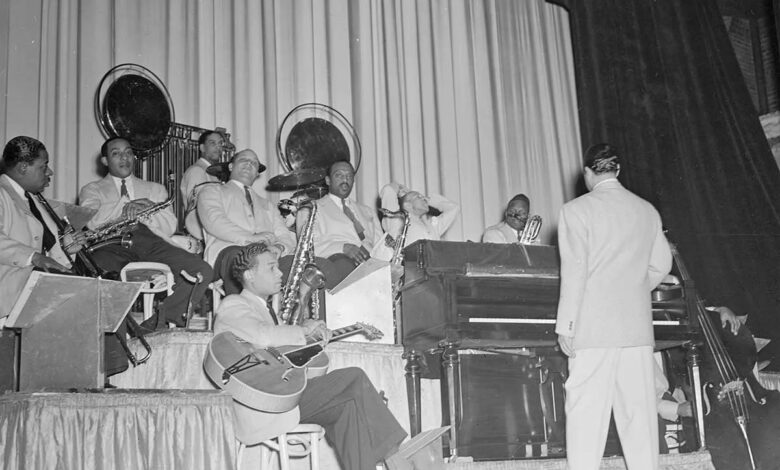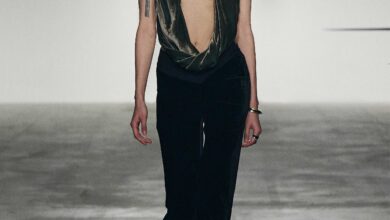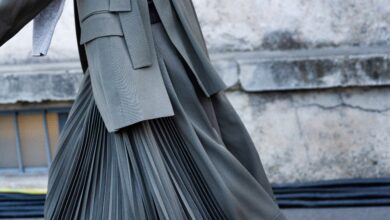How the Acoustic Guitar Kept the Pulse of the Swing Era


During the swing era, roughly 1929 to 1946, professional opportunities for acoustic guitar players reached an all-time high. Even at the depth of the Great Depression, bands performed nationwide for the country’s most popular recreation: dancing. With the dominance of radio and its reliance on live performance during this era, the acoustic guitar held a significant place in the American cultural landscape.
This feature explores the instrument’s resurgence on American bandstands, highlighting its evolving role in swing ensembles. Once overshadowed by louder instruments like the banjo, the guitar reemerged as a key component in the era’s rhythm sections. We’ll examine the techniques and approaches that made it essential for driving the beat and occasionally stepping into the spotlight, tracing its journey through the big band era and its lasting impact on jazz.
Dawning of an Era
It’s common to place the start of the swing era with the Los Angeles debut of Chicago-born, New York–based Benny Goodman at the Palomar Ballroom on August 21, 1935. If that’s the case, then a 20-year-old New York guitarist named Allan Reuss was at the epicenter of what became an international musical phenomenon. Reuss, groomed for the spot by his mentor and predecessor, George Van Eps, spent three years with Goodman during the peak of the clarinetist’s initial success, departing after the famous 1938 Carnegie Hall concert. Reuss’ assertive, steadfast quarter-note rhythm work helped define Goodman’s beat alongside drummer Gene Krupa.
However, the elements that came to define swing-era jazz emerged years before Goodman formed that first orchestra. Much of the music played during the Jazz Age was either intended for dancing or was influenced by dance trends. Those influences shifted toward a looser feel in the late 1920s, as did the music. New dances continued to emerge from African American communities, as they had for decades, creating a symbiotic relationship between the pulse of the dance floor and the beat of the bandstand. With the emergence of the Lindy Hop from Harlem in the late 1920s—and other dances now commonly referred to as swing—a new era began.

In cities like New York, string bass players from New Orleans, including Pops Foster and Al Morgan, made a significant impact. While the string bass had been used in some of the earliest expressions of jazz, its arrival in bands like Luis Russell’s orchestra, which regularly backed Louis Armstrong, helped secure its place on the bandstand in both large and small ensembles, ending two decades of brass-bass dominance.
Partnering with the upright bass in this new-style rhythm section was another instrument that had been used early in jazz: the acoustic guitar. Photos of New Orleans jazz bands near the start of the 20th century show six-string flattops in the hands of players like Jefferson Mumford and Norwood Williams. But as the music and its presentation to the public evolved, the tenor banjo rose in popularity during the 1910s and 1920s. This small, powerful instrument could cut through increasingly large and brass-heavy dance bands, replacing the guitar and becoming synonymous with the syncopated music known as jazz.
Despite efforts by guitarists like Nick Lucas and Bob Gillette in the 1920s to reintroduce the guitar to jazz bands, the plectrist who made the greatest impact during the decade was Philadelphia-born Eddie Lang. His distinctive style and strong beat made him a favorite of bandleaders and musicians alike.
By the decade’s end, Lang was one of the most in-demand musicians in New York, having performed on countless recordings and radio broadcasts. He had secured a prestigious gig in America’s most popular band, led by Paul Whiteman. All of this success brought Lang fame, and he was often photographed with his favored Gibson L-5, the prototypical 16-inch archtop, which he helped popularize. Lang’s career was positioned to survive the Great Depression thanks to his association with radio superstar and former Whiteman vocalist Bing Crosby, but the guitarist tragically died in early 1933 at the age of 30.

Rhythm Methods
Among those influenced by Lang was George Van Eps. In an interview in the 1980s, Van Eps recalled hearing Lang play guitar on the radio with Roger Wolfe Kahn in 1926, noting that Lang was “the first guitar player that was playing guitar in a full-sized dance band. There was no banjo.” Van Eps met Lang, traded his banjo for a guitar, and began working professionally as a teenager. He soon developed an approach to the six-string guitar that had an impact on his peers and older players like Dick McDonough.
Along with stints with the orchestras of Freddy Martin, Benny Goodman, and Ray Noble, Van Eps began teaching in the 1930s. Some of his early students included Allan Reuss, Dave Barbour, Bob Haggart, and Allen Hanlon, all of whom went on to work with big name bands. In 1939, with the help of the Epiphone guitar company, Van Eps published his first method book, which focused on harmonized scales in triads voiced similarly to tenor banjo chords. This method became the core of his approach to chord-melody playing and comping.
Lang’s influence extended far beyond the mainstream dance band world. Rhythm men Fred Guy and Bernard Addison both spoke about his impact, each having spent time in his company. Guy was a member of Duke Ellington’s rhythm section for nearly 25 years, starting off as an exemplary Jazz Age tenor banjo player. His transition to the guitar was more gradual than many of his peers, and he continued playing the banjo into the mid-1930s. Guy was also one of a handful of swing-era guitarists to experiment with the four-string tenor guitar before settling on the standard six-string instrument.
In contrast, Addison, once a member of Jelly Roll Morton’s band, converted to the six-string earlier but retained a lot of banjo technique on the instrument. Additional syncopations, often called jazz strokes in 1920s banjo method books, remained a part of Addison’s rhythm approach deep into the 1930s, often at odds with emerging trends.
The Pulse of Swing
As important as the instruments were, more so was how they were played. Common meter, quarter-note-pulse playing was nothing new in jazz, but it became more prevalent in the late 1920s as the banjo and guitar were increasingly used to hold the beat. Claude Roberts in Chicago with Earl Hines’ influential orchestra, and Dave Wilborn with the popular territory band McKinney’s Cotton Pickers are just two examples of late Jazz Age banjo players devoted to this feel. This pulse was crucial to both the dancers in the ballroom and the musicians on the stage.

These elements all coalesced in New York–based bands of the early 1930s. Fletcher Henderson had long led the most popular Black band in the country, holding extended engagements at the Roseland Ballroom in Times Square. With early swing innovator Walter Johnson on drums, Henderson’s 1931–34 guitar roster included Addison, Clarence Holiday (Billie Holiday’s father), and Lawrence Lucie. In a 2004 interview with jazz historian Phil Schaap, Lucie explained his approach: “The rhythm has to have four beats, but 2 and 4 have to be an accent.” This sanctified feel gave an additional push to the music, emphasizing the backbeat and adding texture. Henderson’s band and rhythm section provided a blueprint for many to follow, including Goodman.
Uptown, a younger bandleader/drummer from Baltimore named Chick Webb emerged with his popular dance band. Using the Savoy Ballroom in Harlem as his base, Webb rose in popularity in parallel with the Lindy Hop, still the most venerable swing dance today. Webb’s exciting drumming and amazing feel were anchored by his longtime section mate John Trueheart, exclusively a guitarist from 1932 onward. Interviewed for the Smithsonian in 1992, New Orleans plectrist Danny Barker, who moved to New York in 1930, spoke about Trueheart: “He was the master. Everybody went to hear him.”
Trueheart’s streamlined, even approach anticipated a major trend in rhythm guitar during the era, but he did so in a loose manner, unafraid of adding subtle syncopations to give what Barker called a “lilt” in the rhythm section. What was important was its core: the music’s heartbeat, its pulse.
America’s Pop Music
The mid-1930s success of Benny Goodman opened the floodgates, marking the only time in history when jazz could be called America’s pop music. As the Depression had devastated the recording industry in the early ’30s, radio emerged as the country’s new mass media. Nationwide broadcasts from New York, Chicago, and Hollywood helped sustain demand for this musical trend.

The country’s appetite for dancing—cheap entertainment during lean years—continued to increase, easily accommodated by the hundreds of ballrooms built throughout the country during the 1910s and 1920s. Radio created a marketplace for one-nighters featuring big bands and ensured good-paying jobs for a generation of guitarists.
As the music’s popularity grew, so did the bands. Fletcher Henderson’s influential 1934 band included 13 musicians. A year later, Goodman opened at the Palomar with 14. By 1939, it was common to see 17 musicians onstage. With expanding bands and increasingly complex arrangements, guitarists fought to be heard. Instrument makers like Gibson and Epiphone introduced both innovations and gimmicks to equip guitarists, or “git-men,” as they were called by the contemporary music press.
Technique changed as well. Allan Reuss had already begun refining Van Eps’ approach, focusing on triads mainly on the top four strings to cut through the band. His modern, streamlined approach was mostly free of the stray syncopations found in the banjo-derived right-hand technique of his peers. He also adopted the Van Eps approach to solo breaks, using double-stops and triads to great effect—an effective alternative to single-string soloing.
It was a challenging era for single-string guitarists, who were mostly confined to small combos in cafes or recording studios. While radio could provide the necessary intimacy, many of these players remained frustrated in dance band situations. Dick McDonough and Carl Kress provided an alternative with their long-revered guitar duets, which were popular on both disc and radio, but had mixed success when they tried to incorporate their concept into dance band records.
Count Basie’s New Sound
For three years, Goodman dominated the jazz world, influencing both white and Black bands. But during the final weeks of 1936, pianist Count Basie brought his first big band and a new rhythm feel to New York. It was a homecoming for the East Coaster, who had settled in the Southwest after falling in love with the sound of the Oklahoma City Blue Devils. Moving to Kansas City, he eventually developed his main musical goal: to lead a large ensemble that could swing like a small group.
At its core was the All-American Rhythm Section: Basie, the section’s architect and ex–Blue Devils leader Walter Page on bass, drummer Jo Jones, and eventually Freddie Green. Green joined in March 1937 after seven years of working around New York cafes. Hours of watching John Trueheart helped Green develop his own technique and rhythm feel, which he further honed in rehearsals with Page and Jones. This approach came to define rhythm guitar playing in jazz.

Green’s style was codified by decade’s end, but he continued to refine it over his 50-year career in the Basie orchestra. He took lessons with Reuss and absorbed Van Eps’ method. He was also known in later years to study cadences on the band bus. Beyond recordings, there are hints of his way of thinking. According to guitarist Steve Jordan in his autobiography, Rhythm Man, Jo Jones described Green’s playing as “rolling the notes out.”
In 1987 Jazz Journal interview, Green himself stated, “A performance has what I call a rhythm wave, and the rhythm guitar can help to keep that wave smooth and accurate.” This typically came from the middle two strings of Green’s guitar, eventually one- and two-note chords augmented by as many additional muted strings in the chord forms as he felt appropriate. Its longevity proves its efficacy: Freddie Green has long been both the name of a jazz legend and shorthand for a playing style.
End of An Era
Swing reached a saturation point in the early 1940s. Demand for bands, radio shows, and records was overtaken by supply, even as orchestra leaders like Glenn Miller enjoyed massive success.
Even the major technological development of the late 1930s—amplification—and the huge impact of electric guitarist Charlie Christian from 1939 onwards did not drastically change the landscape. Some bandleaders experimented with electric guitar in both small groups and big bands, but for most orchestras, the acoustic guitar continued to function primarily as a rhythm instrument.
Everything changed at the end of 1941 with the United States’ entry into World War II. The draft, already underway, accelerated and began emptying bandstands. Wartime rationing impacted travel, curtailing the ability of orchestras to play one-night stands, the main money maker during this era. Curfews were put into effect, particularly on the coasts and in larger cities with abundant servicemen.
Attention shifted toward the war effort, and while bands provided support, they were no longer front-page news. The biggest blow came in 1944 when the federal government imposed a cabaret tax on establishments featuring dancing or vocalists. This significantly severed the tie between the bandstand and the dance floor, forcing venues to hire only the biggest names in the business or to change their musical policies. The vacuum was filled by small combos, often consisting of younger musicians who were developing their own approach to jazz, which would soon emerge as bebop.
Popular tastes quickly shifted to sentimental ballads performed by vocalists backed by orchestras—a reversal of roles from the swing craze of the prior decade. Innovations in songwriting and arranging declined as well. So while swing is often characterized as the soundtrack of the 1940s, in retrospect, it experienced its true decline during the war years. By 1947, all but a handful of the biggest name bands had disbanded.
Swing became something different, returning to its roots as an element of the music rather than a dominant genre of jazz. The acoustic guitar did not entirely disappear from jazz, but it was rarely found on the bandstand. Radio and commercial recording for movies and television continued to employ acoustic guitarists, most of whom had some background in the jazz world, but that job market was minuscule compared to the band business of the 1930s and early 1940s.
Vocalists like Frank Sinatra, a former “boy singer” for Harry James and Tommy Dorsey’s orchestras, demonstrated the long-lasting impact of the swing era. Meanwhile, Freddie Green, who passed away in 1987 at age 75, played his steady, four-square rhythm on an acoustic archtop with Count Basie’s orchestra until the end. His influence endures as a defining example of rhythm guitar playing, bridging the eras of jazz history and leaving a legacy that continues to inspire musicians today.

Essential Listening
Here is a list of ten recordings that define the sound of the acoustic guitar in the swing era in all its time-keeping and harmonic glory. Listen to these tracks on the “Essential Acoustic Swing Guitar”Spotify playlist embedded here.
“Sunday,” Jean Goldkette and His Orchestra, 1926. Eddie Lang, guitar.
“Everybody Loves My Baby,” Earl Hines and His Orchestra, 1929. Claude Roberts, banjo.
“Blue Lou,” Benny Carter and His Orchestra, 1933. Lawrence Lucie, guitar.
“Sugar,” Adrian Rollini and His Orchestra, 1934. George Van Eps, guitar.
“If Dreams Come True,” Chick Webb and His Orchestra, 1934. John Trueheart, guitar.
“If I Could Be With You,” Benny Goodman and His Orchestra, 1935. Allan Reuss, guitar.
“Bump It,” Jimmie Noone and His Orchestra, 1937. Teddy Bunn, guitar.
“Chicken a-la Swing,” Carl Kress and Dick McDonough, 1937.
“Rock-a-Bye Basie,” Count Basie and His Orchestra, 1939. Freddie Green, guitar.
“Alone Together,” Artie Shaw and His Orchestra, 1939, Al Avola, guitar; 1941, Al Hendrickson, guitar.
—NR
Colorful Chords
The notation here is inspired by Allan Reuss’ chord-melody chorus on Benny Goodman’s 1935 “If I Could Be With You” (arranged by Fletcher Henderson). Consisting primarily of quickly moving, three-note chord voicings on the upper strings, it is emblematic of the joy and inventiveness that guitarists like Reuss brought to the swing era. —Adam Perlmutter




